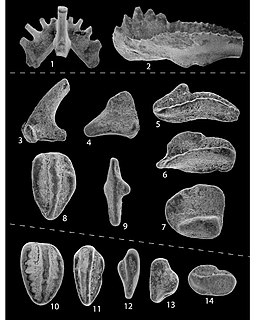Related Research Articles

Conodonts are an extinct group of agnathan (jawless) vertebrates resembling eels, classified in the class Conodonta. For many years, they were known only from their tooth-like oral elements found in isolation and now called conodont elements. Knowledge about soft tissues remains limited. They existed in the worlds oceans for over 300 million years, from the Cambrian to the beginning of the Jurassic. Conodont elements are widely used as index fossils, fossils used to define and identify geological periods. The animals are also called Conodontophora to avoid ambiguity.
Prioniodontida, also known as the "complex conodonts", is a large clade of conodonts that includes two major evolutionary grades; the Prioniodinina and the Ozarkodinina. It includes many of the more famous conodonts, such as the giant ordovician Promissum (Prioniodinina) from the Soom Shale and the Carboniferous specimens from the Granton Shrimp bed (Ozarkodinina). They are euconodonts, in that their elements are composed of two layers; the crown and the basal body, and are assumed to be a clade.
Staurognathus is an extinct genus of conodonts in the family Bactrognathidae from the Middle Dinantian. It is a genus of multielement conodonts.
Cordylodontidae is a family of conodonts.
Palmatolepidae is an extinct conodont family. It is part of the clade Prioniodontida, also known as the "complex conodonts".
Ozarkodina is an extinct genus of conodonts in the family Spathognathodontidae.

Polygnathacea is an extinct superfamily of conodonts.
Spathognathodus is an extinct conodont genus in the family Spathognathodontidae. It is a non-Platform conodont, from the Pennsylvanian (Carboniferous).
Curtognathus is an extinct genus of conodonts from the Ordovician in the family Distacodontidae.
Balognathidae is an extinct conodont family.
Paracordylodontidae is an extinct family of conodonts in the clade Prioniodontida, also known as the "complex conodonts".
Idiognathodus is an extinct conodont genus in the family Idiognathodontidae.

Gnathodus is an extinct conodont genus in the family Idiognathodontidae.
Icriodus is an extinct conodont genus in the family Gnathodontidae.
Alternognathus is an extinct conodont genus in the family Elictognathidae. An extensive study on its population dynamics and lifespan has recently been published.
Epigondolella is an extinct genus of conodonts in the family Gondolellidae.
Gapparodus is an extinct genus of conodonts in the family Furnishinidae. Gapparodus gapparites is a species of the Early Cambrian of Shuijingtuo Formation in China.
Cryptotaxis is an extinct genus of conodonts in the family Cryptotaxidae from the Famennian.
Prioniodinidae is an extinct family of conodonts in the order Prioniodinida.

Panderodus Is an extinct genus of jawless fish belonging to the order Conodonta. This genus had a long temporal range, surviving from the middle Ordovician to late Devonian. Recently, extremely rare body fossils of Panderodus from the Waukesha Biota were described, and it revealed that Panderodus had a more thick body compared to the more slender bodies of more advanced conodonts. It also revealed that this conodont was a macrophagous predator, meaning it went after large prey.
References
- ↑ Family Kockelellidae. G Klapper and DL Clark, Treatise on invertebrate paleontology, Part W: Miscellanea : Conodonts : Conoidal Shells of Uncertain Affinities, Worms, Trace Fossils, and Problema, 1981